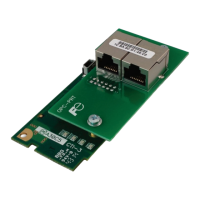9.2.8 Explicit Messaging Via Data Table Read/Write Services
Data table read (0x4C) and data table write (0x4D) services provide a direct method of accessing the
inverter function codes by reference to “tag names”. Tags are read via the EtherNet/IP “data table read”
servic e, and written via the EtherNet/IP “data table write” servic e.
To read data, the client must reference a starting “source element” and the “number of elements” to
read. Similarly, to write data, the client must reference a starting “destination element” and the “number
of elements” to write. The “number of elements” can be any quantity from 1 to the maximum allowable
length, while the “source element” and “destination element” must be tag names constructed according
to the naming conventions shown in section 9.2.9. The elements are 16-bit values.
9.2.9 Inverter Function Code Access Tag Format
Any inverter function code (refer to section 4) can be accessed with its own unique tag name, or an
array tag can be used to access a group of function codes with one PLC instruction. The “tag name” is
essentially the ASCII representation of the function code itself. Tag names are generated acc ording to
the following structure:
[function code group][function code offset]
Where
[function code group] is a [1 to 2]-character field, and is the ASCII character(s) for the function code’s
group. The characters are case-sensitive. Refer to Table 14.
[function code offset] is a 2-character field corresponding to the function code offset. If the offset is
less than 10, it must be pre-pended by 0. Valid offsets are “00” to “99”.
Examples
“Acceleration time 1” ....................F07
“Frequency command” .................S05
“Operation status”.........................M14
“Output power” .............................W22
“Life of cooling fan” .......................W168
For explicit messaging examples, refer to sections 9.2.13 and 9.2.14.
9.2.10 ControlLogix Examples: Setup
This section will demonstrate how to initially setup a ControlLogix PLC (such as a 1756-L61) coupled
with a 1756-ENBT/A communication interface (adjust this procedure according to your specific
equipment). Later sections will provide specific read/write examples using this configuration with I/O or
explicit messaging.
1) Run RSLogix 5000, and create a new configuration.
2) To add a 1756-ENBT/A to your I/O configuration, first switch to offline mode.
3) Right click on the I/O Configuration node in the controller organizer view and choose “New
Module…”
4) The “Select Module” window will open.
5) Select the “1756-ENBT/A”, and click “Create”. Refer to Figure 41.

